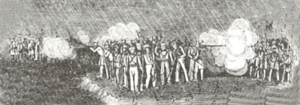Sanyuanli incident facts for kids
Quick facts for kids Sanyuanli incident (三元里抗英事件) |
|||||||
|---|---|---|---|---|---|---|---|
| Part of the Battle of Canton | |||||||
 Military situation map of the Sanyuanli Incident |
|||||||
|
|||||||
| Belligerents | |||||||
| Commanders and leaders | |||||||
| Hugh Gough Humphrey Senhouse |
Unknown | ||||||
| Strength | |||||||
| 6,000 | 20,000–30,000 militia and local villagers | ||||||
The Sanyuanli incident (Chinese: 三元里抗英事件) was a fight between British soldiers and Chinese villagers. It happened near Sanyuanli village, outside Canton (now Guangzhou), on May 29-30, 1841. This event took place during the First Opium War (1839-1842).
The British saw it as a small fight. But for the Chinese, it was a big deal. They saw it as a time when ordinary people stood up against a foreign army.
Contents
What Happened at Sanyuanli?
Before the Fight
On May 25, 1841, British forces were ready to attack Canton. Their leader was Major-General Hugh Gough. They had captured several Chinese forts.
But then, the Qing government agreed to British demands. They promised to pay money and for British troops to leave. So, the attack on Canton was stopped on May 27.
The Villagers Fight Back
Nearly 5,000 British and Indian soldiers were waiting near Canton. They were in the hot, wet fields. Some soldiers took things from villages like Sanyuanli. This made the local people very angry.
Soon, about 10,000 villagers gathered. They came from nearby areas. They surrounded the British soldiers. The villagers had knives, spears, and swords.
They tricked 60 British soldiers into a marshy field. It was raining heavily. The British guns, called flintlock muskets, got wet and would not fire. The villagers attacked. Four British soldiers died, and more than twenty were hurt.
The British sent more soldiers to help. These new soldiers had waterproof guns. After two hours, the British soldiers went back to a fort. But the villagers followed them and surrounded them again.
The British commander sent a message to the governor of Guangzhou. He warned that if the villagers did not stop, the British army would destroy Canton. The governor knew this was a real threat. He told the crowd to leave. But the villagers called him a traitor for doing this.
What Was the Impact?
A Governor's Reputation
The governor, Yu Baochun, lost his good name. He could only get a small job after this. He worked in a department for important exams. Patriotic students would even throw ink in his face.
Remembering the Event
At the main spot of the fight, there is a small hill. It is called Niulangang. On May 23, 1991, a simple concrete memorial was built there. It was to remember 150 years since the Sanyuanli incident.


